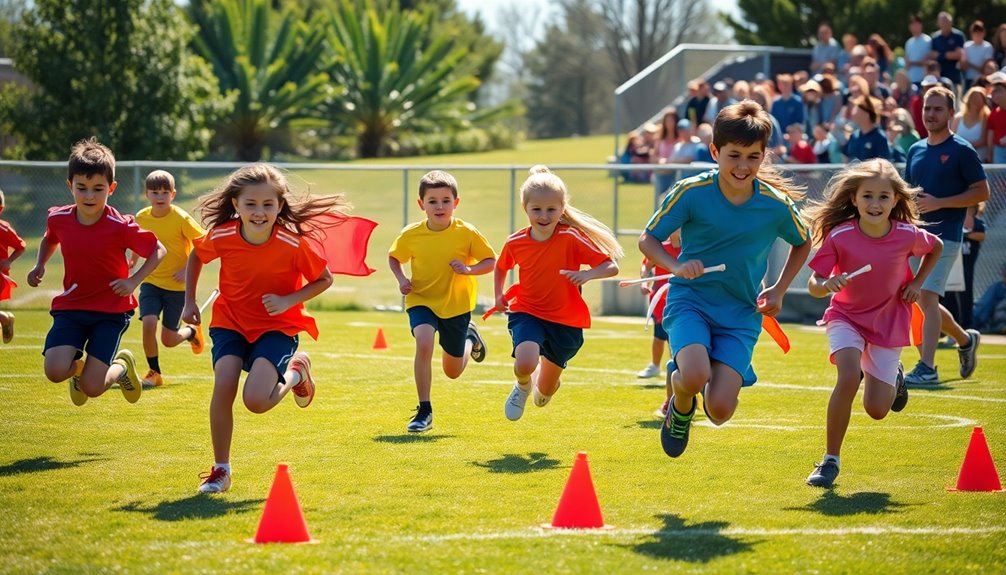
Improve Your Game With These Flag Football Drills
January 9, 2025To improve your game with flag football drills, focus on honing essential skills. Work on footwork drills to boost agility and speed, which are critical for both offensive and defensive plays. For wide receivers, mastering routes enhances your versatility, while running backs benefit from agility drills that help in breaking tackles. Quarterbacks can improve accuracy with targeted passing and quick decision-making drills. Don't forget the importance of teamwork; collaborative exercises promote communication and understanding on the field. Keep practicing these fundamentals, and you'll see significant progress in your performance. There's more to explore to refine your flag football skills.
Overview of Flag Football Drills
Flag football drills are vital for players looking to hone their skills and elevate their game. If you're involved in youth flag football, mastering the fundamentals is essential for your success on the field.
With over 50 available drills designed to enhance various skills, you can focus on both offensive and defensive techniques. These drills improve your footwork, agility, and overall game confidence, especially in a 5-on-5 gameplay environment.
Engaging in youth flag football drills not only builds your individual skills but also promotes teamwork and communication on the field. Understanding essential skills such as dribbling and passing can significantly improve your overall performance, making you a more effective player.
Flag pulling drills, for example, emphasize non-contact techniques that highlight the importance of speed and agility in defensive play. Incorporating agility drills helps you navigate tight spaces, allowing for quicker movements and seamless shifts during games.
Position-Specific Drills
Mastering position-specific drills is essential for any flag football player looking to excel in their role. For wide receivers, focusing on specific drills can make all the difference in your performance on the field.
Start by practicing the 15 essential routes. Knowing how to run these routes effectively will give you an edge over defenders and help your quarterback find you during critical moments.
Incorporate advanced footwork drills to improve your agility and speed. These drills will teach you the necessary directional changes needed to create separation from defenders. Additionally, developing sharp shooting skills can enhance your ability to make impactful plays when the opportunity arises. Regular practice of agility training can further enhance your quickness and responsiveness on the field.
Remember, quick footwork is key to maneuvering tight spaces and adapting to changing game situations.
Don't overlook ball-catching drills either. Work on your hand-eye coordination and catching techniques to guarantee that you can reliably secure the ball when it comes your way. Additionally, mastering communication on the field can enhance your ability to coordinate with teammates and improve overall gameplay.
Running Back Skills Development
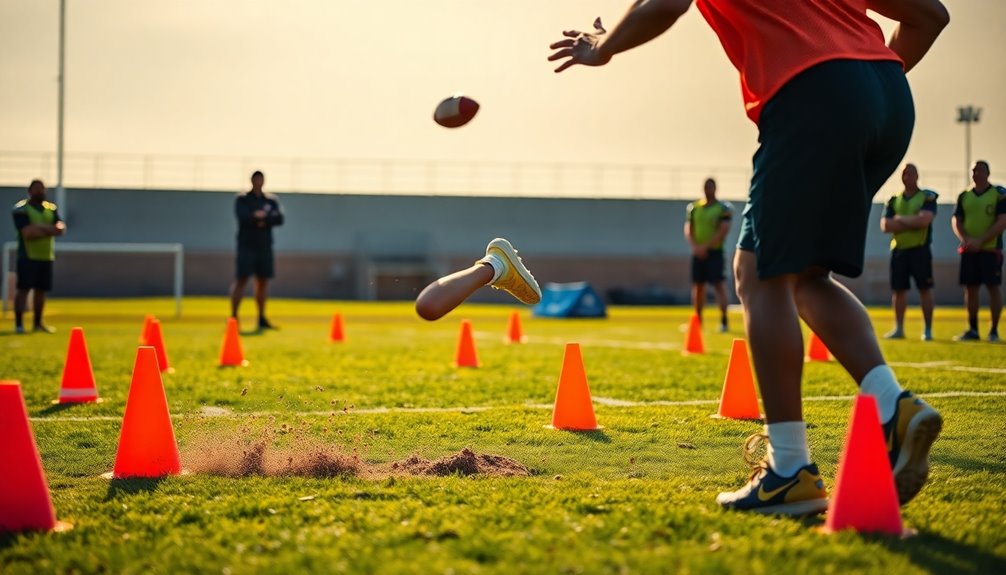
Effective running back skills development is essential for any player aiming to dominate on the field. To become a standout running back, focus on enhancing your speed and agility through targeted drills. These skills are significant for breaking tackles and maneuvering through defenses effectively during gameplay. Additionally, mastering technical skills is crucial for executing precise movements under pressure.
Field vision is another key component. By practicing drills that sharpen your ability to quickly identify openings, you'll make split-second decisions that optimize your yardage gains. Incorporating speed, agility, and endurance workouts into your training regimen can significantly elevate your performance.
Quick footwork drills are equally important; they help you execute sharp cuts and directional changes, which are essential for evading defenders.
Incorporating route mapping into your training is important for synchronizing with quarterbacks. This collaboration creates dynamic passing options and improves your team's offensive strategies.
Additionally, dodge drills are a must-have in your regimen. They refine your ability to maneuver around defenders, increasing your overall effectiveness on the field. Engaging in core strength exercises will also enhance your balance and stability, contributing to your overall performance as a running back.
Quarterback Precision Techniques
As a running back sharpens their skills on the field, the quarterback's precision techniques play an important role in creating a successful offense. To enhance your throwing accuracy, focus on proper hand placement and grip. This guarantees a consistent release point for better precision in your passes.
Next, practice footwork fundamentals through drop-back drills. These are essential for setting up your throws and maintaining balance under pressure. Incorporating drills that emphasize quick decision-making and reading defenses will allow you to adapt your throws based on the game situation. Additionally, engaging in agility exercises can significantly improve your footwork and overall movement on the field, as enhancing speed and agility is crucial for quarterback effectiveness.
Furthermore, utilize targeted passing drills that require you to throw on the run. This helps improve your accuracy while maintaining speed and momentum during gameplay.
It's also critical to develop a consistent throwing motion. Focus on drills that help you achieve a perfect spiral, as this contributes greatly to the distance and accuracy of each pass. Incorporating reaction training into your practice will further enhance your ability to make accurate throws under pressure.
Wide Receiver Route Training
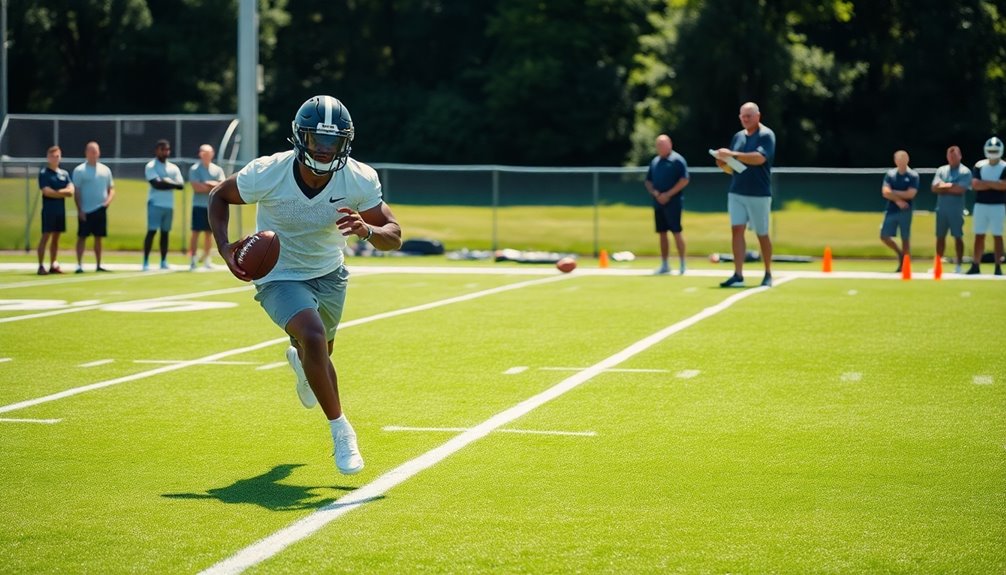
Wide receivers need to practice at least 15 fundamental routes, like slants, posts, and outs, to boost their versatility on the field. Mastering these routes allows you to adapt to various game situations and keep defenders guessing.
Advanced footwork drills are important for wide receivers; they help you make sharp cuts and create separation from defenders. Practicing directional changes at high speeds builds the agility necessary for maneuvering through tight coverages effectively. The quicker you can change direction, the harder it becomes for defenders to keep up. Incorporating pain shuttles drill into your training can further enhance your speed and agility, enabling you to outmaneuver defenders even more effectively.
Incorporating game-like scenarios into your training is significant for developing the ability to read defenses and adjust your routes in real-time. These drills simulate actual game conditions, preparing you for the unpredictability of live play.
Lastly, consistent route mapping and timing with your quarterback during drills is essential for building chemistry. When you and your quarterback are in sync, your execution during games becomes precise, increasing your chances of making successful plays. Emphasizing team coordination in your practice will enhance your overall performance on the field.
Defensive Flag Pulling Drills
In defensive flag pulling, mastering effective techniques is key to successfully removing flags from offensive players.
You'll need to understand the importance of pursuit angles, as they can make or break your chances of making a play. Additionally, practicing defensive stance drills can enhance your agility and positioning, making it easier to execute successful flag pulls. Effective anticipation skills can also significantly improve your ability to predict an offensive player's movements and react accordingly. Developing a keen sense of timing and distance will elevate your flag pulling game to the next level.
Effective Flag Pulling Techniques
Mastering effective flag pulling techniques is essential for any defender wanting to excel in flag football. To improve, start with drills like "One on One Flag Pulling." This drill not only boosts your speed but also sharpens your reaction time against offensive players, which is critical when pulling flags under pressure.
The "Sweep Drill" is another important exercise. It helps you learn the correct flag pulling technique while moving laterally, simulating real game scenarios. This drill is effective for players of all ages, reinforcing body positioning to maintain a good angle of pursuit.
Incorporating agility drills into your practice can greatly enhance your ability to change direction quickly. This skill is important for effectively chasing down opponents and avoiding being outmaneuvered.
Pursuit Angle Importance
Understanding pursuit angles is often vital for defenders aiming to excel in flag football. The pursuit angle you choose can greatly impact your ability to close the distance between yourself and the ball carrier, which is essential for successful flag pulling.
By mastering the correct pursuit angles, you'll maintain ideal speed and positioning, leading to quicker and more efficient flag pulls during game situations.
Here are some key points to remember about pursuit angles:
- Ideal positioning helps you anticipate the ball carrier's movements.
- Faster reactions improve your chances of making a successful flag pull.
- Practice drills, like the One on One Flag Pulling drill, develop your technique.
- Teamwork is enhanced when players understand how to support each other defensively.
- Young players should focus on learning the best pursuit angles to avoid missed opportunities.
Agility Improvement Drills
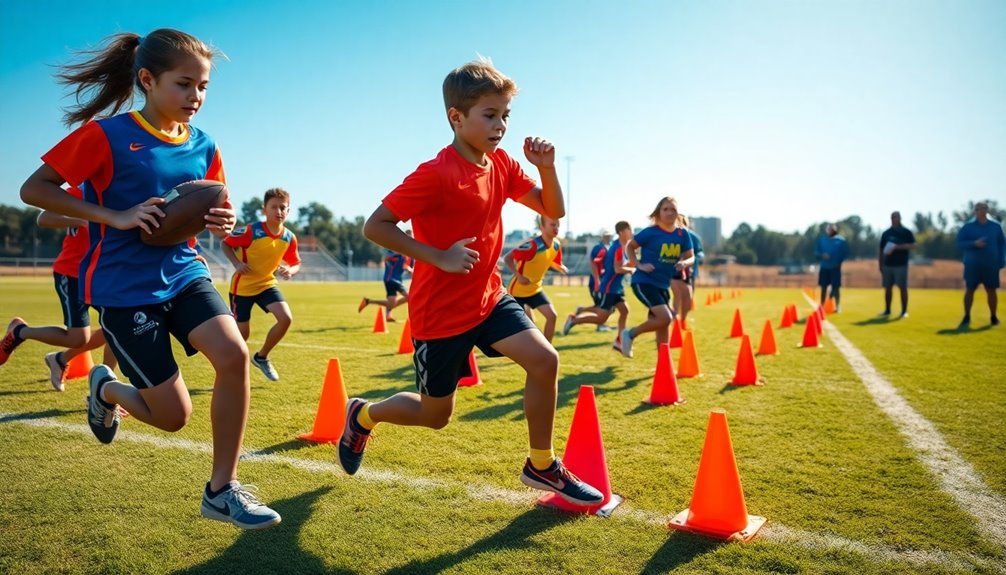
To excel in flag football, agility improvement drills are essential for enhancing your quick footwork and speed. These agility drills help you navigate tight spaces and execute sharp movements during gameplay.
Start by incorporating cone drills into your routine. They'll improve your shift movements, allowing you to change direction rapidly while maintaining control of your body.
Next, utilize ladder drills to boost your foot speed and coordination. This will develop the agility necessary for both offensive and defensive roles on the field. Regular practice of these drills not only enhances your physical abilities but also sharpens your mental game, enabling you to make quick decisions under pressure.
Shuttle runs and zig-zag sprints are also vital. They simulate game situations, training you to react quickly while evading defenders or closing in on offensive players.
By regularly engaging in these agility drills, you'll notice a marked improvement in your overall game performance. You'll become more adept at adapting to fast-paced gameplay, giving you a competitive edge on the field.
Embrace these agility drills to take your flag football skills to the next level!
Fundamental Catching Techniques
Catch the ball with confidence by honing your fundamental catching techniques. Mastering these skills not only increases your catching success but also prepares you for the fast-paced nature of flag football.
Here are some key points to focus on:
- Proper Body Alignment: Position yourself to receive the ball effectively, reducing the chance of drops.
- Hand Positioning: Use your fingers and thumbs to create a target; catch the ball with your hands, not your body.
- Eyes on the Ball: Keep your eyes locked on the ball until you secure it, minimizing distractions.
- Tuck the Ball: Once you've caught it, tuck the ball against your body to protect it from defenders and prepare for your next move.
- Practice Adaptability: Incorporate drills that simulate game situations, catching while running or with defenders nearby.
Throwing Mechanics and Accuracy
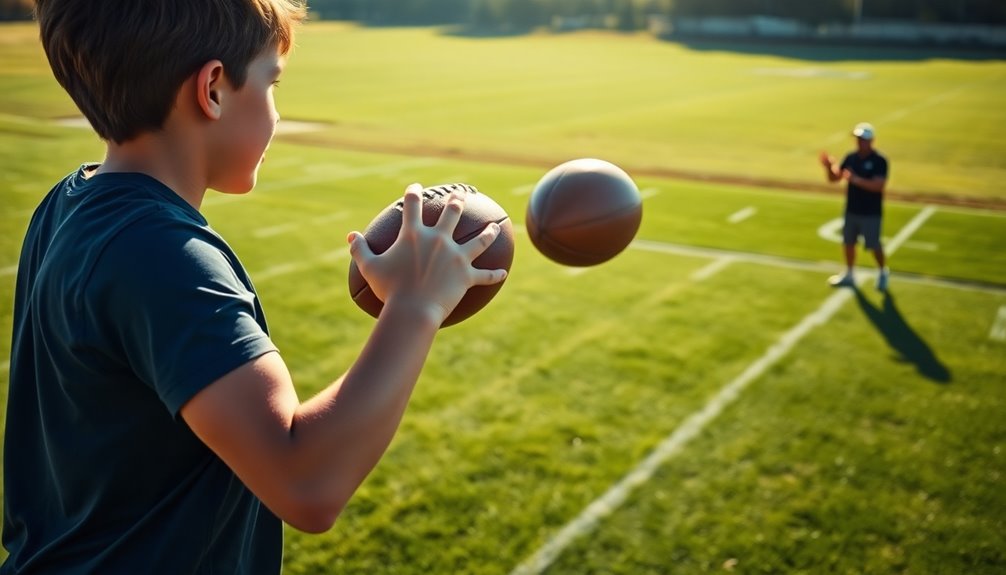
While mastering your throwing mechanics, you'll find that proper hand placement and grip on the football are vital for achieving both control and accuracy. Start by positioning your fingers on the laces, ensuring a firm grip without squeezing too tightly. As you prepare to throw the ball, focus on your throwing motion. Break it down into a smooth release and a strong follow-through to maximize your power and precision.
Footwork is another important aspect of your throwing mechanics. Practicing footwork fundamentals helps you maintain balance and stability, allowing you to throw the ball with greater consistency. Incorporate drills that emphasize lateral movement and quick foot placement, so you can adapt to different game situations.
Additionally, practice throwing at varying distances and angles to enhance your adaptability. This will improve your ability to throw accurately, no matter the scenario. Consistent practice of throwing drills not only helps you develop a tight spiral but also reduces the chances of wobbling passes, which can lead to interceptions.
Snapping Techniques for Success
Mastering snapping techniques is vital for any player looking to excel in flag football. It all starts with your stance; whether you choose a two-point or three-point position, make certain you're stable and ready for the snap.
A seamless shift from the snap to the quarterback is important, so practice drills that emphasize rhythm and timing to enhance your coordination. Communication is key—prior to the snap, verify you and the quarterback are on the same page regarding the play call and snap count.
Focus on drills that develop both short and long snaps to improve your accuracy and distance. This won't only help you succeed during plays but also prevent turnovers.
Here are some tips to perfect your snapping techniques:
- Use a firm grip on the ball.
- Keep your eyes on the target (the quarterback).
- Maintain a consistent snap motion.
- Practice quick shifts to offensive support.
- Work on your blocking skills post-snap.
Game Strategy and Teamwork
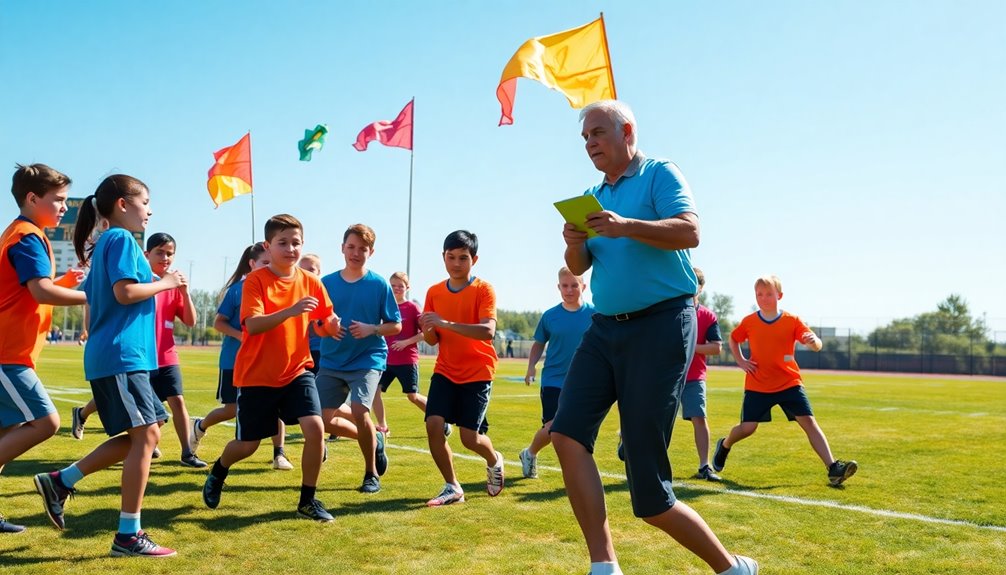
After honing your snapping techniques, the next step is to focus on game strategy and teamwork. Effective communication among team members is essential in 5-on-5 flag football. Make sure everyone understands their roles and responsibilities during plays to keep the game running smoothly.
A strategic approach to both offensive and defensive gameplay allows your team to adapt to opponents' tactics and exploit weaknesses. Regularly practice situational drills to foster teamwork. These drills help players, including the ball carrier, make quick decisions under pressure, leading to improved game execution.
Emphasizing scoring strategies and defensive tactics creates a balanced team that can perform well in various scenarios. Incorporate drills that focus on teamwork, as they build trust among players and enhance the ability to work together seamlessly.
This trust becomes important during high-stakes moments in games, where split-second decisions can make a difference. By prioritizing game strategy and teamwork, you'll not only improve individual skills but also elevate your entire team's performance on the field.
Offensive Play Execution
Executing offensive plays effectively is essential for success in flag football. You need to guarantee that your offensive play execution is sharp to maximize scoring opportunities.
Here are some key focus areas to improve your performance:
- Clean Handoffs: Practice smooth handoffs during drills to minimize fumbles. Every dropped ball can disrupt your momentum.
- Game-like Passing Drills: Incorporate scenarios that simulate game pressure, allowing quarterbacks and receivers to build synergy.
- Route Running with Cones: Set up cones to practice essential routes. This will enhance your agility and precision on the field.
- Teamwork: Emphasize communication and coordination among players. Successful execution relies heavily on everyone knowing their role.
- Agility Moves: Regularly practice agility techniques during warm-ups. This helps players evade defenders and maintain ball possession in dynamic situations.
Defensive Play Strategies
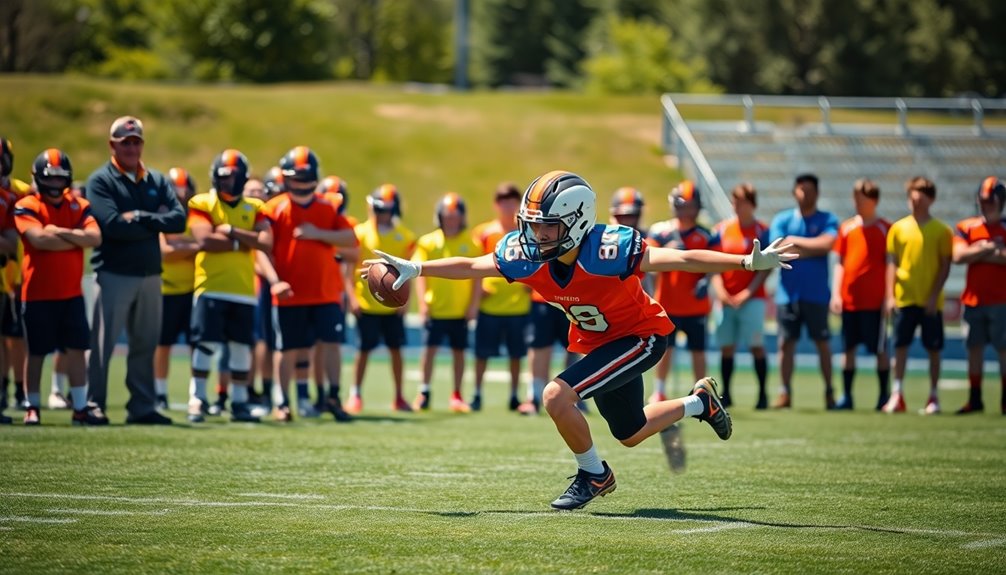
While offensive play execution sets the stage for scoring, strong defensive strategies are equally important in flag football. To enhance your defensive effectiveness, mastering flag-pulling techniques is essential. You should practice through drills focusing on angles of pursuit and reaction time, ensuring you can quickly and accurately remove your opponent's flags.
Incorporating drills like the Sweep Drill and One on One Flag Pulling will help you maintain speed and agility while closing in on the offensive player. Understanding man-to-man coverage strategies allows you to anticipate their movements and adjust your positioning, leading to more successful flag pulls.
Situational awareness is key during defensive drills. It helps you develop quick decision-making skills under pressure, allowing you to adapt to the offensive team's tactics in real-time.
Additionally, regularly engaging in conditioning drills will enhance your stamina and agility, ensuring you remain effective throughout the game.
Differences Between Flag and American Football
Flag football and American football may share a common origin, but they differ markedly in gameplay, rules, and player dynamics. In flag football, the primary objective is to pull the flags from the ball carrier to stop play, while American football involves tackling players to the ground. This fundamental difference creates a wider emphasis on agility and speed in flag football, where physical contact isn't allowed.
Here are some key differences you should know:
- Team Size: Flag football typically features a 5-on-5 format, fostering teamwork and strategic play.
- Contact Rules: Physical contact is limited, encouraging players to focus on evading defenders rather than overpowering them.
- Tactics: The game relies heavily on quick passing and route-running, unlike the complex blocking schemes in American football.
- Skill Development: Mastery of moves like spins and jukes is essential for avoiding defenders effectively.
- Player Dynamics: Flag football promotes a wide range of player skills, as everyone needs to be versatile.
Understanding these differences helps you appreciate the unique aspects of flag football and refine your skills on the field.
Conclusion
By incorporating these flag football drills into your practice, you'll transform your skills faster than a cheetah on a caffeine rush! Whether you're dodging defenders like a ninja or throwing spirals that could launch satellites, these techniques will elevate your game to legendary status. Your teammates will marvel at your newfound prowess, and opponents will tremble at the sight of you on the field. Get ready to dominate and leave your mark in the flag football universe!


